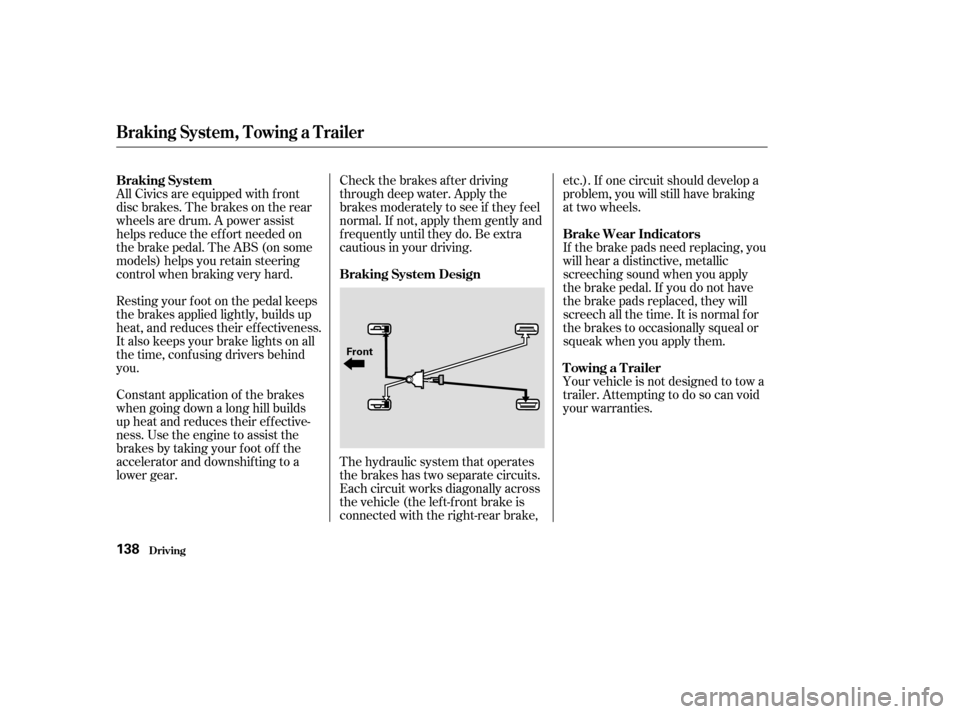Page 111 of 231

Even with the cruise control turned
on, you can still use the accelerator
pedal to speed up f or passing. Af ter
completing the pass, take your foot
of f the accelerator pedal. The vehicle
will return to the set cruising speed.
Resting your f oot on the brake or
clutch pedal will cause the cruise
control to cancel.Pressing the Cruise Control Master
Switch turns the system completely
of f and erases the previous cruising
speed.
Youcancancelthecruisecontrolin
any of these ways:
Tap the brake or clutch pedal.
Push the CANCEL button on the
steering wheel.
Press the Cruise Control Master
Switch. When you push the CANCEL button,
or tap the brake or clutch pedal, the
system remembers the previously-
set cruising speed. To return to that
speed, accelerate to above 25 mph
(40 km/h) then press the RESUME/
accel button. The CRUISE
CONTROL light comes on, and the
vehicle will accelerate to the same
cruising speed as bef ore.
Cruise Control
Comf ort and Convenience Feat ures
Cancelling the Cruise Control
Resuming the Set Speed
112
�����—�����—�����y�
�����������
�y���
�(���%�������y���
�
���y
Page 115 of 231
Put your f ingers under the f ront
edge of the hood to the right of
the center. Slide your hand to the
lef t until you f eel the hood latch
handle. Push this handle up to
release it. Lift up the hood.If the hood latch handle moves
stif f ly, or if you can open the hood
without lifting the handle, the
mechanism should be cleaned and
lubricated.
Park the vehicle, and set the
parking brake. Pull the hood
release handle located under the
lower lef t corner of the dashboard.
The hood will pop up slightly. Pull the support rod out of its clip,
and insert the end into the hole on
the f ront lef t side of the hood.
1. 2.3.To Open the Hood:
Service Station Procedure
Opening and Closing the Hood
Bef ore Driving116
HOOD
RELEASE
HANDLE
LATCH
�����—�����—�����y�
�������������y���
�(���%�������y���
�
���y
Page 116 of 231
Lif t it up slightly to remove the
support rod f rom the hole. Put the
support rod back into its holding
clip. Lower the hood to about a
f oot (30 cm) above the f ender,
then let it drop. Make sure it is
securely latched.Remove the dipstick again and
check the level. It should be
between the upper and lower
marks.
Wait a f ew minutes af ter turning the
engine of f bef ore you check the oil.
Remove the dipstick.
Wipe the dipstick with a clean
cloth or paper towel.
Insert it all the way back in its tube. If it is near or below the lower mark,
see on page .
3.
1. 2. 4.
152
To Close the Hood:
Service Station Procedure
Bef ore Driving
Oil Check
A dding Engine Oil
117
SUPPORT RODGRIP
CLIP DIPSTIC UPPER MARK
LOWER MARK
�����—�����—�����y�
���������
���y���
�(���%�������y���
�����y
Page 119 of 231

Your dealer has Honda accessories
that allow you to personalize your
vehicle. These accessories have
been designed and approved f or your
vehicle, and are covered by warranty.When properly installed, cellular
phones, alarms, two-way radios, and
low-powered audio systems should
not interf ere with your vehicle’s
computer controlled systems, such
as the SRS and anti-lock brake
system.Bef ore installing any accessory:
Modif ying your vehicle, or installing
some non-Honda accessories, can
make your vehicle unsaf e. Bef ore
you make any modif ications or add
anyaccessories,besuretoreadthe
f ollowing inf ormation. Make sure the accessory does not
obscure any lights, or interf ere
with proper vehicle operation or
perf ormance.
Be sure electronic accessories do
not overload electrical circuits
(see page ) or interf ere with
proper operation.
Have the installer contact your
Honda dealer f or assistance bef ore
installing any electronic accessory.
Although aftermarket accessories
may f it on your vehicle, they may not
meet f actory specif ications, and
could adversely af f ect your vehicle’s
handling and stability (see
‘‘Modif ications’’ on page f or
additional information). 121 199
A ccessories
Bef ore Driving
A ccessories and Modif ications
120
Improper accessories or
modifications can affect your
vehicle’s handling, stability, and
performance, and cause a
crash in which you can be hurt
or killed.
Follow all instructions in this
owner’s manual regarding
accessories and modifications.
�����—�����—�����y�
�������������y���
�(���%�������y���
�����y
Page 125 of 231
Fasten your seat belt. Check that
your passengers have f astened
their seat belts (see page ).
When you start the engine, check
the gauges and indicator lights in
the instrument panel (see page).
Make sure the doors are securely
closed and locked.
Check the steering wheel
adjustment (see page ).
Check the adjustment of the
inside and outside mirrors (see
page ).
Check that any items you may be
carrying are stored properly or
f astened down securely.
Check the seat adjustment (see
page ).
Youshoulddothefollowingchecks
and adjustments every day bef ore
you drive your vehicle.
Make sure all windows, mirrors,
and outside lights are clean and
unobstructed. Remove f rost, snow,
or ice.
Check that the hood and trunk are
f ully closed.
Visually check the tires. If a tire
looks low, use a gauge to check its
pressure.
1. 2. 3. 4.
9.
8.
7.
6.
5.
10.
76
83 68 14
53
Driving
Preparing to Drive
126
�����—�����—�����y�
�������������y���
�(���%�������y���
�����y
Page 136 of 231

Always use the parking brake when
you park your vehicle. Make sure
the parking brake is set f irmly or
your vehicle may roll if it is on an
incline.Make sure the moonroof and the
windows are closed.
Turn of f the lights.
Place any packages, valuables, etc.
in the trunk or take them with you.
Lock the doors.
If your vehicle has an automatic
transmission, set the parking brake
bef ore you put the transmission in
Park. This keeps the vehicle f rom
moving and putting pressure on the
parking mechanism in the
transmission.
Never park over dry leaves, tall
grass, or other f lammable
materials. The hot three way
catalytic converter could cause
these materials to catch on fire.If the vehicle is f acing uphill, turn
the f ront wheels away f rom the
curb. If you have a manual
transmission, put it in f irst gear.
If the vehicle is f acing downhill,
turn the front wheels toward the
curb. If you have a manual
transmission, put it in reverse gear.
Make sure the parking brake is
f ully released bef ore driving away.
Driving with the parking brake
partially set can overheat or
damage the rear brakes.
Driving
Parking T ips
Parking
137
�����—�����—�����y�
�������������y���
�(���%�������y���
�����y
Page 137 of 231

Check the brakes after driving
through deep water. Apply the
brakes moderately to see if they f eel
normal. If not, apply them gently and
f requently until they do. Be extra
cautious in your driving.
All Civics are equipped with f ront
disc brakes. The brakes on the rear
wheels are drum. A power assist
helps reduce the ef f ort needed on
thebrakepedal.TheABS(onsome
models) helps you retain steering
control when braking very hard.
Resting your f oot on the pedal keeps
the brakes applied lightly, builds up
heat, and reduces their ef f ectiveness.
It also keeps your brake lights on all
the time, conf using drivers behind
you.
Constant application of the brakes
when going down a long hill builds
up heat and reduces their ef f ective-
ness. Use the engine to assist the
brakes by taking your f oot of f the
accelerator and downshif ting to a
lower gear.
The hydraulic system that operates
the brakes has two separate circuits.
Each circuit works diagonally across
the vehicle (the lef t-f ront brake is
connected with the right-rear brake,etc.). If one circuit should develop a
problem, you will still have braking
at two wheels.
If the brake pads need replacing, you
will hear a distinctive, metallic
screeching sound when you apply
the brake pedal. If you do not have
the brake pads replaced, they will
screech all the time. It is normal f or
the brakes to occasionally squeal or
squeak when you apply them.
Your vehicle is not designed to tow a
trailer. Attempting to do so can void
your warranties.
Braking System, Towing a Trailer
Driving
Braking System Design
Braking System
Brake Wear Indicators
Towing a Trailer
138
Front
�����—�����—�����y�
�������������y���
�(���%�������y���
���
�y
Page 140 of 231

This section explains why it is
important to keep your vehicle well
maintained and how to f ollow basic
maintenance saf ety precautions.
This section also includes
Maintenance Schedules f or normal
driving and severe driving conditions,
a Maintenance Record, and instruc-
tions f or simple maintenance tasks
you may want to take care of
yourself .
If you have the skills and tools to per-
f orm more complex maintenance
tasks on your Honda, you may want
to purchase the Service Manual. See
page f or inf ormation on how to
obtain a copy, or see your Honda
dealer.......................
Maintenance Saf ety . 142
.................
Maintenance Schedule . 143
....................
Maintenance Record . 149
..............................
Fluid Locations . 151
........................
Adding Engine Oil . 152
.........
Changing the Oil and Filter . 154
....................
Windshield Washers . 156
..............................
Engine Coolant . 157
....................
Power Steering Fluid . 159
....
Automatic Transmission Fluid . 160
........
Manual Transmission Fluid . 162
....................................
Timing Belt . 162
................
Brake and Clutch Fluid . 163
.............................................
Lights . 164
.......................................
Seat Belts . 169
.....................................
Floor Mats . 169
..................
Dust and Pollen Filter . 169
.................................
Wiper Blades . 170
...............................................
Tires . 172
...................
Checking the Battery . 178
.............................
Vehicle Storage . 179
221
Maintenance
Maint enance141
�����—�����—�����y�
�������������y���
�(���%�������y���
�����y